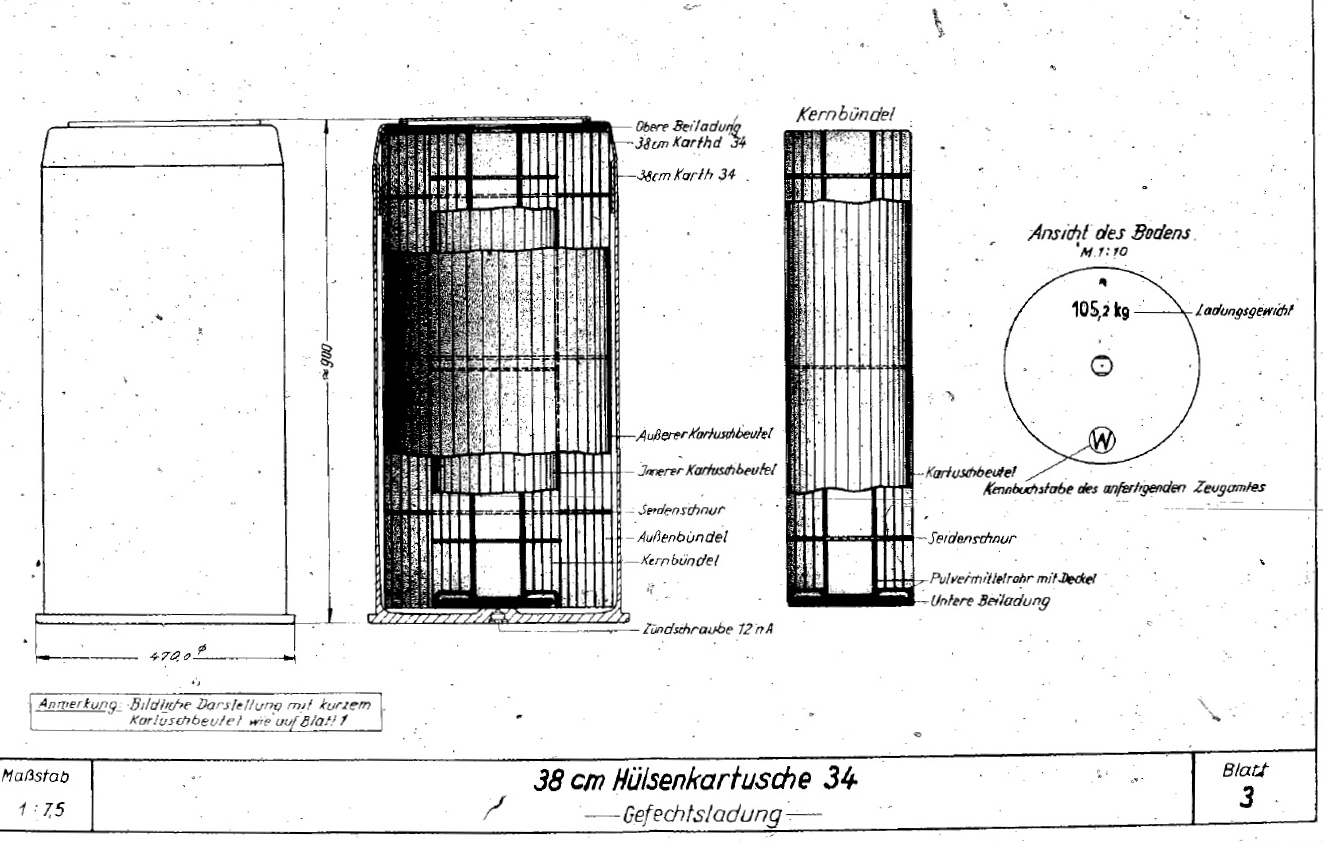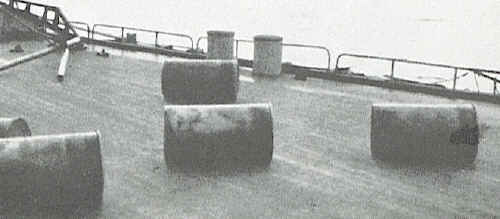You are using an out of date browser. It may not display this or other websites correctly.
You should upgrade or use an alternative browser.
You should upgrade or use an alternative browser.
Battleship Gun Propellant
- Thread starter Smokin'Joe
- Start date
Cool video, thanks. I've toured the USS North Carolina museum in Wilmington a couple of times and got to see the inside of the magazine. Very interesting and I enjoyed the technical explanation of how it works
http://www.worldwar2facts.org/uss-n...tructed battleship to see service during WW 2.
http://www.worldwar2facts.org/uss-n...tructed battleship to see service during WW 2.
A popular myth about the 16 inch guns is their recoil moves battleships several feet sideways.
It's actually several thousandths of an inch.
http://www.navweaps.com/index_tech/tech-022.php
It's actually several thousandths of an inch.
http://www.navweaps.com/index_tech/tech-022.php
A popular myth about the 16 inch guns is their recoil moves battleships several feet sideways.
I've heard that too. When you see photos from above when firing it does give the appearance that the ship moving, but it is just blast from the guns on the water below the barrels.
https://www.bing.com/images/search?...8fa7750e681?rik=4Sjo61tu0Vg4qg&pid=ImgRaw&r=0
Jim Watson
New member
As I recall, there is a little black powder for easy ignition and to transmit the fire from one bag to the next.
The Lake Denmark Naval Ammunition Depot stored munitions left over from WWI.
When struck by lightning in 1926 they learned that the distance between bunkers was inadequate and maybe that the powder was not very stable.
The Olsen Process for Ball Powder was originally developed to reprocess such stuff into small arms powder. I don't know if they ever did much, but there sure has been a lot of Ball powder made out of fresh ingredients since then.
The Lake Denmark Naval Ammunition Depot stored munitions left over from WWI.
When struck by lightning in 1926 they learned that the distance between bunkers was inadequate and maybe that the powder was not very stable.
The Olsen Process for Ball Powder was originally developed to reprocess such stuff into small arms powder. I don't know if they ever did much, but there sure has been a lot of Ball powder made out of fresh ingredients since then.
Mike Irwin
Staff
Each powder bag has about 4 pounds of black powder on the rear to act as a primer booster.
I see from that video that it differs from information given by guides at the USS North Carolina. The video states that a full charge was always used, while I was told that gunners could adjust the number of charges from 3 to 6 depending on range and trajectory. Granted, the college kid guide likely knows nothing about propellants, firearms, or battleship gunnery. I would assume that they were given that information though. Or possibly college kid was adding information that sounded reasonable to rehearsed lines. Who knows.
There are two reasons for bagged charges in artillery, one if for ease of handling (think what a 16" metallic case would weigh) and also for ease of adjustment of powder charge allowing greater flexibility of range adjustment than barrel elevation alone.
When you get up to battleship main gun size the difference in rate of fire between bagged charges and cased ammo isn't that significant. the difference in complexity of handling and cost, is.
One big point in favor of "caseless" ammo is not having a huge fired case that needs to be handled, moved out of the way, and then moved to storage or tossed out. During WWII the Germans built some enormous land artillery that used metallic cases. But their big naval artillery was bagged charges.
If you're shooting a railroad gun a huge fired case (and they're HOT!) can just be shoved to the ground and picked up later (for reloading) but you don't want one of those rolling around loose in a gun turret, or two or three from each salvo...
When you get up to battleship main gun size the difference in rate of fire between bagged charges and cased ammo isn't that significant. the difference in complexity of handling and cost, is.
One big point in favor of "caseless" ammo is not having a huge fired case that needs to be handled, moved out of the way, and then moved to storage or tossed out. During WWII the Germans built some enormous land artillery that used metallic cases. But their big naval artillery was bagged charges.
If you're shooting a railroad gun a huge fired case (and they're HOT!) can just be shoved to the ground and picked up later (for reloading) but you don't want one of those rolling around loose in a gun turret, or two or three from each salvo...
Mike Irwin
Staff
" But their big naval artillery was bagged charges."
No. No they weren't. At least not exclusively.
The German military -- BOTH land and sea forces -- used sliding-wedge breech mechanisms, which required a brass case to seal the breach.
Krupp, the primary supplier of heavy armaments, experimented with interrupted screw obturation pad breech mechanisms, but one was never adopted into service
The casing was not what we think of when we think of a case... It was short and did not contain all of the powder charge. Depending on the gun, it might come with 1 or 2 bagged charges already in the case, with the rest of the charges loaded in loose bags, or (especially with the larger guns) the bagged charges were loaded and then the empty case was inserted into the breech.
The case already had the primer installed in it.
This is, I think, the case for a German 21-cm siege mortar, but the main guns on every German battleship, battle cruiser, or heavy cruiser would have used something very similar.

No. No they weren't. At least not exclusively.
The German military -- BOTH land and sea forces -- used sliding-wedge breech mechanisms, which required a brass case to seal the breach.
Krupp, the primary supplier of heavy armaments, experimented with interrupted screw obturation pad breech mechanisms, but one was never adopted into service
The casing was not what we think of when we think of a case... It was short and did not contain all of the powder charge. Depending on the gun, it might come with 1 or 2 bagged charges already in the case, with the rest of the charges loaded in loose bags, or (especially with the larger guns) the bagged charges were loaded and then the empty case was inserted into the breech.
The case already had the primer installed in it.
This is, I think, the case for a German 21-cm siege mortar, but the main guns on every German battleship, battle cruiser, or heavy cruiser would have used something very similar.
Mike Irwin
Staff
Here we go...
From the Naval weapons page, a sketch of the Bismarck-class ammunition.
The brass casing used to seal the breech DID contain a a charge, known as the forecharge.

From the Naval weapons page, a sketch of the Bismarck-class ammunition.
The brass casing used to seal the breech DID contain a a charge, known as the forecharge.

Mike Irwin
Staff
And an equally interesting picture...
The Naval Weapons site says that this is a picture of expended brass cases lying on the deck of the Tirpitz after gunnery exercises.

The Naval Weapons site says that this is a picture of expended brass cases lying on the deck of the Tirpitz after gunnery exercises.

Jim Watson
New member
This is, I think, the case for a German 21-cm siege mortar, but the main guns on every German battleship, battle cruiser, or heavy cruiser would have used something very similar.
Sure is shiny.
What brand case tumbler do you use for an 8"?
Cement mixer, no particular brand.Sure is shiny.
What brand case tumbler do you use for an 8"?
Mike Irwin
Staff
"What brand case tumbler do you use for an 8"? "
Gewehrblastemflatz
Gewehrblastemflatz
I did Artillery for a living for several years. I can't speak for Naval Artillery but land based artillery is categorized as Semi-Fixed and Separate Loading. Both types use Nitro Cellulose powder (I imagine the Navy does too) .
Semi-Fixed has a brass shell casing in which the increments are placed. Then the actual round is placed on the casing and a fuze is attached and set. The entire round is then placed in the chamber of the cannon prepatory to firing.
Separate loading ammunition is fused and the fuse is set then the projectile is rammed into the chamber of the cannon and the powder is loaded behind it.
I can't speak for the Navy but the Army researches the performance characteristics of each lot of powder until they are known as exactly as they can be.
Several variables are then accounted for (altitude, temperature, wind speed, rotation of the earth) and the final solution is set. In the Navy the fact that one or both the target and the gun are moving is also accounted for and the gun is fired.
Coastal Artillery Powder Increments

Land Based 155mm Powder Increments

The Red Bag on the end of the propellant bags is black powder and acts as an Ignitor for the Nitro Cellulose
Semi-Fixed has a brass shell casing in which the increments are placed. Then the actual round is placed on the casing and a fuze is attached and set. The entire round is then placed in the chamber of the cannon prepatory to firing.
Separate loading ammunition is fused and the fuse is set then the projectile is rammed into the chamber of the cannon and the powder is loaded behind it.
I can't speak for the Navy but the Army researches the performance characteristics of each lot of powder until they are known as exactly as they can be.
Several variables are then accounted for (altitude, temperature, wind speed, rotation of the earth) and the final solution is set. In the Navy the fact that one or both the target and the gun are moving is also accounted for and the gun is fired.
Coastal Artillery Powder Increments

Land Based 155mm Powder Increments

The Red Bag on the end of the propellant bags is black powder and acts as an Ignitor for the Nitro Cellulose
Last edited:
That sounds more like what you shoot them from."What brand case tumbler do you use for an 8"? "
Gewehrblastemflatz
Thank you for the correction. I was unaware the DKM naval rifles used cases, I assumed they did what everyone else did, but apparently not. Naval Artillery is not my strong suit, though I am pretty familiar with WWII tank guns up through 128mm.
I am also a bit familiar with US 81mm and 4.2" mortars. The "four deuce" uses "donuts" of powder charges and trust me, the one fire call you didn't want to get at your mortar track was "charge zero"! That meant that the bad guys were within rifle range of YOU!! Time to shoot and scoot!
Time to shoot and scoot!
I am also a bit familiar with US 81mm and 4.2" mortars. The "four deuce" uses "donuts" of powder charges and trust me, the one fire call you didn't want to get at your mortar track was "charge zero"! That meant that the bad guys were within rifle range of YOU!!
Mike Irwin
Staff
The German Army in World War II did field some artillery pieces that used obturator pad breech mechanisms.
But they were all captured, primarily from the Russians, along with enough shells and charges that it made sense to incorporate them.
But they were all captured, primarily from the Russians, along with enough shells and charges that it made sense to incorporate them.
